We could terraform Mars with desert moss. Among its recent discoveries, the rover found rocks made of pure sulfur. From October 2023, the rover will explore a region of Mars rich in sulfates, a type of salt containing sulfur and formed when water evaporates. NASA finds ice on Mars with new map. NASA selects commercial service research to support robotic science on Mars. owe Industries is currently developing a propulsion system that can generate up to 100,000 N of thrust with a specific impulse (Isp) of 5,000 seconds, the high efficiency of the system allows for manned missions to Mars to be completed in just two months.
Earth desert moss is able to withstand the Martian climate. It almost always comes back to life even if it has lost more than 98% of its water reserves, and it is able to withstand “Martian” temperatures for three and five years.
Chinese biologists have discovered that the desert moss Syntrichia caninervis can survive complete dehydration and still come back to life after spending about five years at minus 80 degrees Celsius or about a month at minus 196 degrees Celsius. This makes the moss suitable for colonizing Mars, they write in an article in the scientific journal Innovation.
“Our experiments show that Syntrichia caninervis has a higher resistance to adverse environmental conditions than other super-resistant organisms, including extremophile microbes and tardigrades. This makes this moss a promising candidate for the role of a “pioneer” organism for the colonization of extraterrestrial habitats and the formation of an environment favorable for human life beyond Earth,” the researchers write.
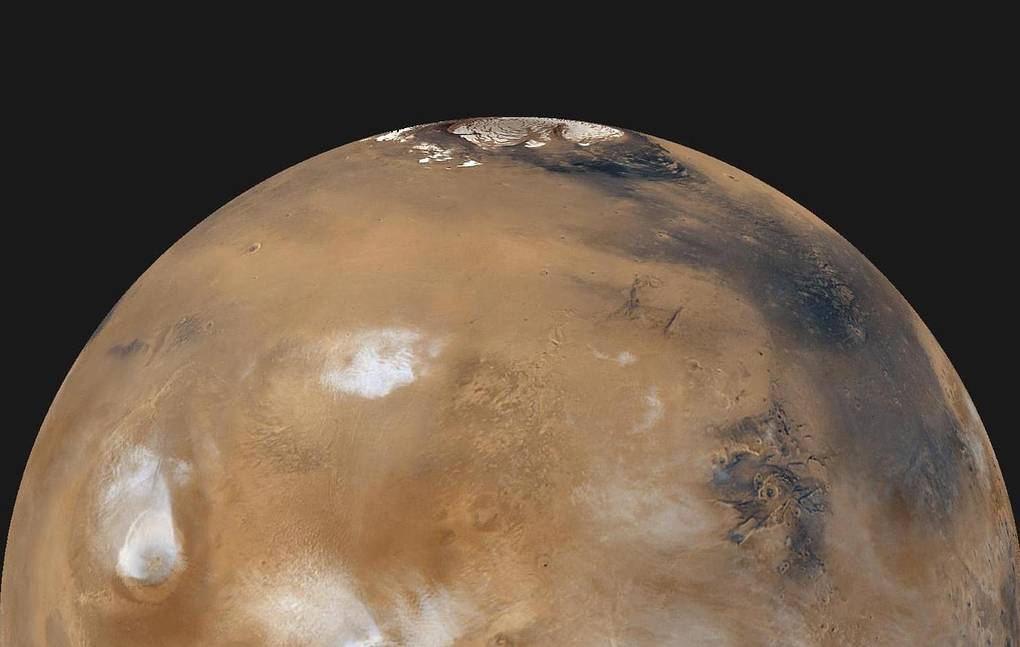
Mars. NASA/JPL/MSSS
This conclusion was reached by a group of Chinese biologists led by Zhang Daoyuan, a research fellow at the Xinjiang Institute of Ecology and Geography of the Chinese Academy of Sciences in Urumqi, during a comprehensive study of the life of moss of the Syntrichia caninervis species, which is found in most desert regions of the Earth. This type of vegetation is able to withstand sharp temperature changes and a constant lack of moisture, which makes it especially interesting for study in the context of colonizing other planets.
With this in mind, the researchers tracked how the desert moss responded to conditions typical of Mars, the closest planet to Earth where life may have existed in the past. These experiments examined how Syntrichia caninervis responded to prolonged dehydration, as well as to prolonged temperatures as low as minus 80 degrees Celsius, which is typical of the equatorial regions of Mars during the winter.
Experiments have shown that this species of desert moss almost always returns to life even if it has lost more than 98% of its water reserves, and it is able to withstand “Martian” temperatures for three and five years. Moreover, studies have shown that Syntrichia caninervis is able to return to life even after a month of immersion in liquid nitrogen.
In addition, it was found that moss tolerates very large doses of gamma radiation, about 1,000 gray (over 110,000 biological equivalents of roentgens), without any visible consequences for the regeneration and growth rate of this plant. This makes it an ideal candidate for the role of a “pioneer” organism for the colonization of Mars and other planets with a climate remotely similar to Earth, the researchers concluded.
Desert moss could be the key to terraforming Mars, according to a recent study published by Chinese scientists.
Thanks to its extraordinary resilience, Syntrichia caninervis (S. caninervis), a moss that grows in extreme desert environments from Tibet to Antarctica, has been called a “pioneer plant” for creating a habitable environment on Mars. In fact, scientists believe the plant could enrich the planet’s rocky surface, allowing other plants to grow, The Innovation reported on July 1, 2024.
Several studies have explored alternatives to these terraforming seeds, such as algae and lichens. “However, plants such as mosses offer key advantages for terraforming, including stress tolerance, high photoautotrophic growth capacity, and the potential to produce significant amounts of biomass in challenging environments,” the new study team wrote in the paper.
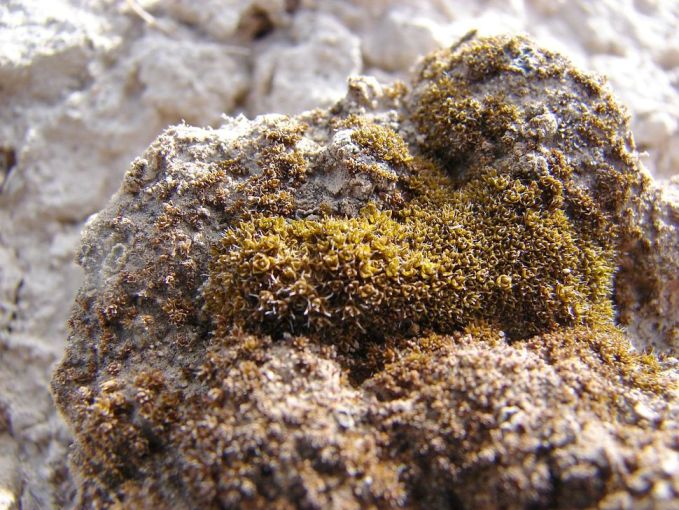
Moss Syntrichia caninervis. USDA-NRCS PLANTS
Mosses are thought to have been the first true land plants on Earth. As such, they developed resistance to extreme stress, allowing them to survive the very harsh conditions of early life on our planet.
The scientists exposed whole S. caninervis plants to conditions typical of Mars: high doses of gamma radiation, low oxygen levels, extreme cold and drought. They report that the plants could withstand combinations of these conditions, even losing more than 98% of their water content and still recover within seconds – “desiccation without death” was the term used. Perhaps even more astonishing is the plant’s ability to recover and regrow branches after being stored in a freezer at -80 degrees Celsius (-112 degrees Fahrenheit) for five years, or in liquid nitrogen (-195.8 degrees Celsius; -320.44 degrees Fahrenheit) for one month.
“The unique morphological features of S. caninervis, such as the rolled leaves, conserve water by minimizing surface area and reducing transpiration, while the awns provide effective photoprotection against intense UV radiation, extreme temperatures, and water loss,” the team writes. “Meanwhile, the cell wall, cell membrane, and chloroplast and its membrane structure remain intact even in a completely dehydrated state.”
When stressed, S. caninervis enters a state of “selective metabolic dormancy,” strategically conserving key metabolites—products of cellular metabolic pathways—needed for its rapid recovery. “For example, S. caninervis plants maintain high levels of sucrose and maltose after stress; these sugars serve as osmotic agents and protective substances that help maintain and stabilize cellular architecture,” the scientists write. “The sugars subsequently provide the energy needed for rapid recovery after stress conditions are relieved.”
Stress also activates genes that code for photoprotective proteins and enzymes that help clear harmful reactive oxygen species produced by radiation. “Multilayer tolerance provides protection under stressful conditions and ensures rapid recovery of cells and physiological activity when conditions suitable for growth occur,” the team said.
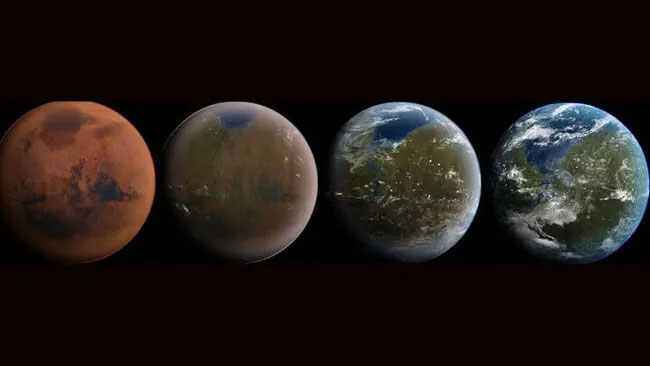
A visualization of what Mars might look like over time if humans were able to terraform the planet. CC BY-SA
These findings, the scientists continue, lay the groundwork for creating sustainable human habitats beyond Earth. Whether this claim is an exaggeration will depend on future experiments – and may not even be achievable in our lifetimes – but one important element missing from the discussion is not the feasibility of the science, but the ethics behind it.
This concept of terraforming another planet is not new and has its roots in science fiction. And while the concept has been romanticized and discussed in the media in recent times, there are serious concerns about the extraterrestrial social consequences of completely converting an entire planet for human habitation.
For example, in an essay titled “The Thorny Ethics of Planetary Engineering,” astrophysicist and NASA researcher Erika Nesvold puts the dilemma quite clearly: “The goal of terraforming is to intentionally create an entire ecosystem on a global scale, which would likely destroy any existing ecosystem,” she wrote. “Terraforming technology may even become feasible before we have definitively determined whether alien life exists on the planet or moon we hope to transform.”
“But suppose we find evidence of microbial life on a planet like Mars,” she continued. “Should that disqualify Mars from being a terraforming target? Should we avoid settling Mars altogether?”
Among its recent discoveries, the rover found rocks made of pure sulfur — a first on the Red Planet. Scientists were stunned on May 30, 2024, when a rock the Curiosity rover drove over cracked, revealing something never seen before on the Red Planet: yellow sulfur crystals.
Since October 2023, the rover has been exploring a region of Mars rich in sulfates, a type of salt containing sulfur that forms when water evaporates. But where sulfur-based minerals — in other words, a mix of sulfur and other materials — have been found in the past, the rock Curiosity recently uncovered is made of elemental, or pure, sulfur. It’s unclear what, if any, relationship the elemental sulfur has to other sulfur-based minerals in the area.
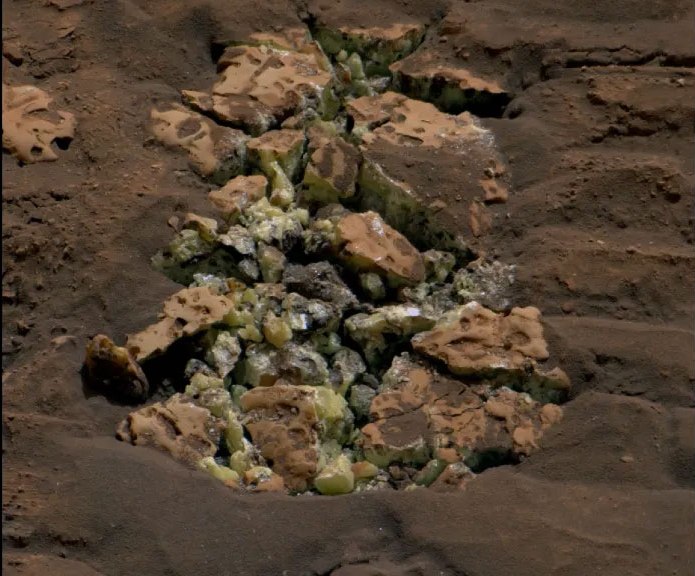
These yellow crystals were discovered after the rover ran over and cracked a rock on May 30. Using a tool on the rover’s robotic arm, scientists later determined that the crystals were elemental sulfur — the first time that type of sulfur has been found on Mars. NASA
While people associate sulfur with the smell of rotten eggs (a result of hydrogen sulfide being released), elemental sulfur is odorless. It forms only under a narrow range of conditions that scientists don’t connect to the history of the place. And Curiosity found it in abundance — a field of brightly colored rocks similar to the one the rover crushed.
“Finding a rock field made of pure sulfur is like finding an oasis in the desert,” said Curiosity project scientist Ashwin Vasavada of NASA’s Jet Propulsion Laboratory in Southern California. “It shouldn’t be there, so now we have to explain it. Finding weird and unexpected things is what makes planetary exploration so exciting.”
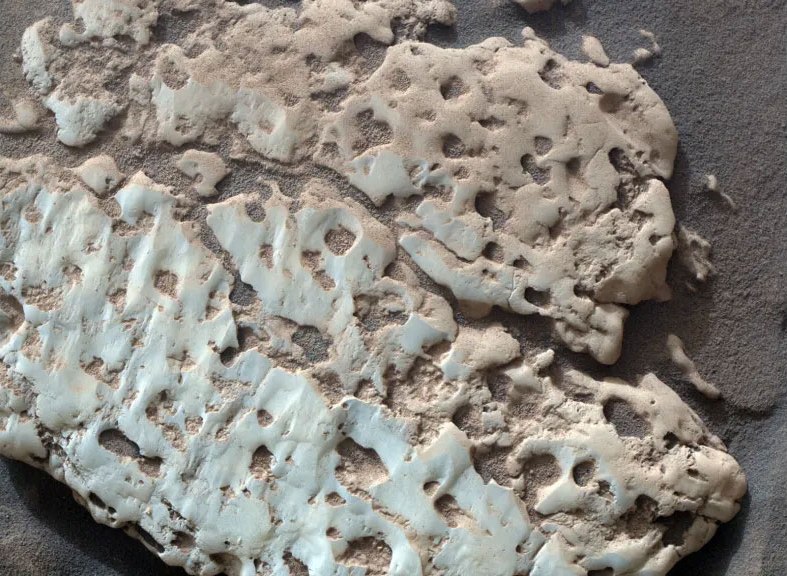
Snow Lake Rock. June 8, 2024, on the 4209th Martian day, or sol, of the mission. Nine days earlier, the rover had crushed a similar-looking rock and found crystalline structures and elemental sulfur inside.
It’s one of several discoveries Curiosity has made while driving off-road in the Gediz Vallis Channel, a trench that snakes down a section of the 3-mile-high (5-kilometer) Mount Sharp that the rover has been climbing to since 2014. Each layer of the mountain represents a different period of Martian history. Curiosity’s mission is to study where and when the planet’s ancient terrain might have provided the nutrients needed for microbial life, if it ever formed on Mars.
Spotted from space several years before Curiosity launched, the Gediz Vallis Channel is one of the main reasons the science team wanted to visit this part of Mars. Scientists believe the channel was carved by flows of liquid water and debris that left a ridge of boulders and sediment that extends 2 miles down the mountainside below the channel. The goal was to better understand how this landscape changed billions of years ago, and while recent clues have helped, there is still much to learn from this dramatic landscape.
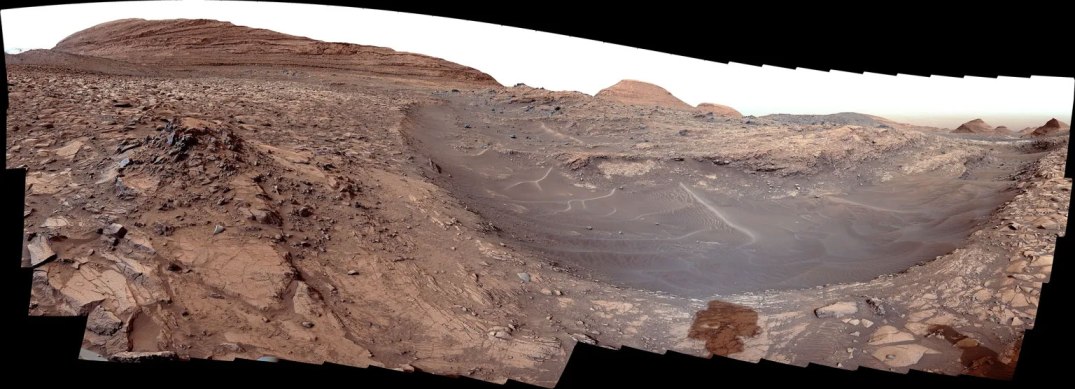
NASA’s Curiosity rover captured this image of the Gediz Valley channel on March 31. The area was likely formed by strong flows of water and debris that piled up piles of rocks in the channel. NASA/JPL-Caltech/MSSS
Since Curiosity arrived in the canal earlier this year, scientists have been studying whether the large mounds of debris that rise from the canal floor were formed by ancient floods or landslides. Curiosity’s latest data suggests both played a role: Some mounds were likely left behind by strong flows of water and debris, while others appear to be the result of more localized landslides.
These conclusions are based on the rocks found in the debris mounds: while rocks carried by water currents are rounded like river rocks, some of the debris mounds are strewn with more angular rocks that may have been deposited by dry avalanches.
Eventually, the water soaked up all the material that had settled there. Chemical reactions caused by the water discolored the white “halo” shapes on some of the rocks. Erosion from wind and sand over time revealed these halo shapes.
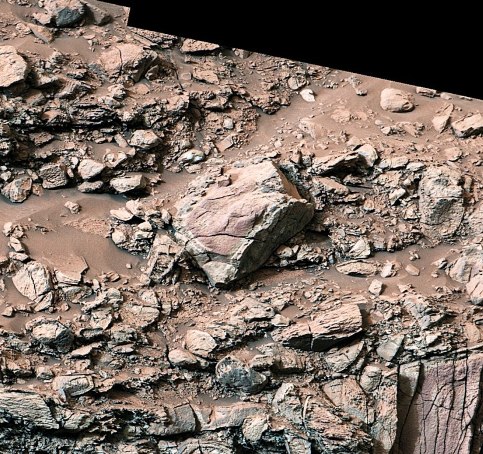
While exploring the Gediz Vallis Channel in May, NASA’s Curiosity captured this image of rocks that are pale in color around the edges. These rings, also called halos, resemble markings seen on Earth when groundwater seeps into rocks through cracks, causing chemical reactions that change color. NASA/JPL-Caltech/MSSS
“This hasn’t been a quiet time on Mars,” said Becky Williams, a scientist at the Planetary Science Institute in Tucson, Arizona, and deputy principal investigator of Curiosity’s Mast Camera (Mastcam). “There’s been a fascinating amount of activity here. We’re seeing several flows down the channel, including energetic floods and boulder-rich flows.”
All this evidence of water continues to tell a more complex story than the team initially expected, and they were eager to take a rock sample from the canal to learn more. On June 18, they got their chance.
While the sulfur rocks were too small and fragile to drill into, a large rock nicknamed “Mammoth Lakes” was found nearby. Rover engineers had to find a section of rock that would allow them to drill safely and find a place to park on the loose, sloping ground.
After Curiosity drilled the 41st hole using the powerful drill on the end of the rover’s 7-foot (2-meter) robotic arm, the six-wheeled scientist sprinkled crushed rock into tools inside its belly for further analysis so scientists could determine what materials the rock was made of. Curiosity has since left Mammoth Lakes and is now off to see what other surprises await it in the canal.
NASA finds ice on Mars with new map. The map could help the agency decide where the first astronauts should land on the Red Planet. The more water that is available, the less missions will need to carry.
The buried ice would be a vital resource for the first humans to set foot on Mars, serving as drinking water and a key ingredient in rocket fuel. But it would also be an important scientific target: Astronauts or robots could one day drill ice cores just as scientists do on Earth, revealing Mars’s climate history and exploring potential habitats (past or present) for microbial life.
The need to look for subsurface ice arises because liquid water is unstable on the surface of Mars: the atmosphere is so thin that water evaporates immediately. There is a lot of ice at the poles of Mars — mostly water, although carbon dioxide or dry ice can also be found — but these regions are too cold for astronauts (or robots) to survive there for long.
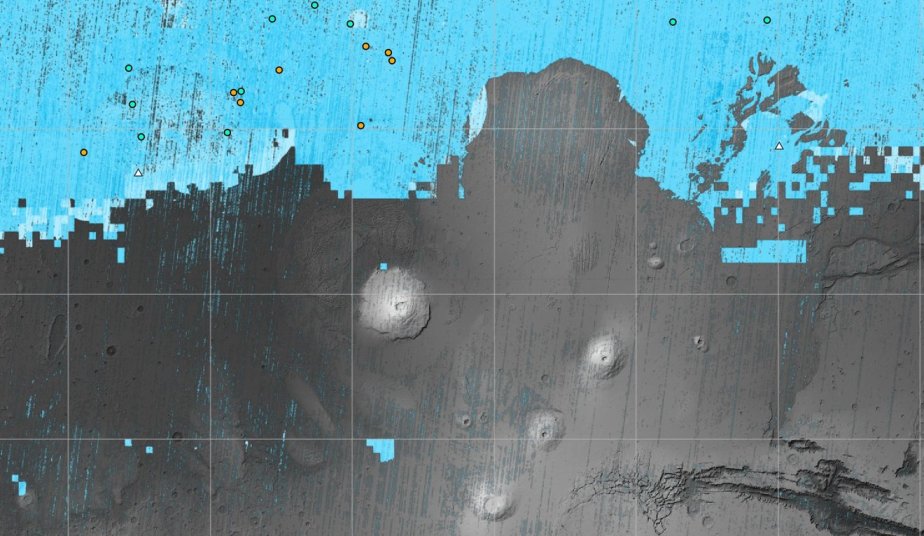
The blue areas on this map are regions where NASA missions have discovered subsurface water ice.
That’s where the NASA-funded Groundwater and Ice Mapping Project comes in. SWIM, as it’s called, recently released its fourth set of maps, the most detailed since the project began in 2017.
SWIM, led by the Planetary Science Institute in Tucson, Arizona, and managed by NASA’s Jet Propulsion Laboratory in Southern California, collects data from multiple NASA missions, including the Mars Reconnaissance Orbiter (MRO), 2001 Mars Odyssey, and the now-inactive Mars Global Surveyor. Using a combination of data sets, scientists have identified the most likely locations for Martian ice that could be accessed from the surface by future missions.
Instruments on these spacecraft have detected what appear to be masses of subsurface frozen water along the mid-latitudes of Mars. The northern mid-latitudes are particularly attractive because they have a thicker atmosphere than most other regions on the planet, making it easier to slow a descending spacecraft. The ideal landing site for astronauts would be at the southernmost edge of this region — far enough north that ice is present, but close enough to the equator to provide the warmest temperatures possible for astronauts in the icy region.
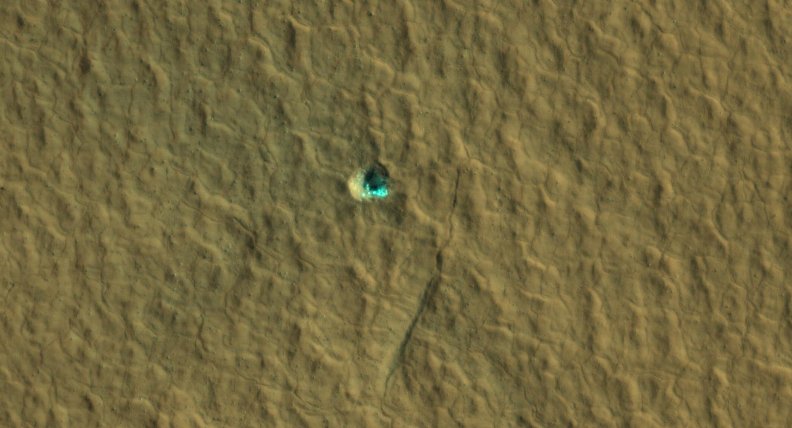
The ice-exposed crater at the center of this image is an example of what scientists are looking for when mapping the places where future astronauts might land on Mars. It is one of several such impacts included in the latest version of a series of NASA-funded maps of subsurface water ice on the Red Planet. NASA/JPL-Caltech/University of Arizona
“If you’re sending people to Mars, you want them as close to the equator as possible,” said Sydney Do, SWIM project manager at JPL. “The less energy you spend keeping astronauts and their support equipment warm, the more you have available for other things.”
Previous versions of the map relied on lower-resolution thermal imagers, radar, thermal mappers, and spectrometers, all of which can hint at buried ice but cannot directly confirm its presence or quantity. For the latest SWIM map, scientists relied on two higher-resolution cameras aboard MRO. Context Camera data was used to further refine the northern hemisphere maps, and for the first time, HiRISE (High-Resolution Imaging Science Experiment) data was included to provide the most detailed perspective of the ice boundary line as close to the equator as possible.
Scientists regularly use HiRISE to study fresh impact craters caused by meteorites that may have torn out chunks of ice. Most of these craters are no more than 33 feet (10 meters) in diameter, though in 2022 HiRISE captured an impact crater 492 feet (150 meters) wide that revealed a vein of ice lurking beneath the surface.
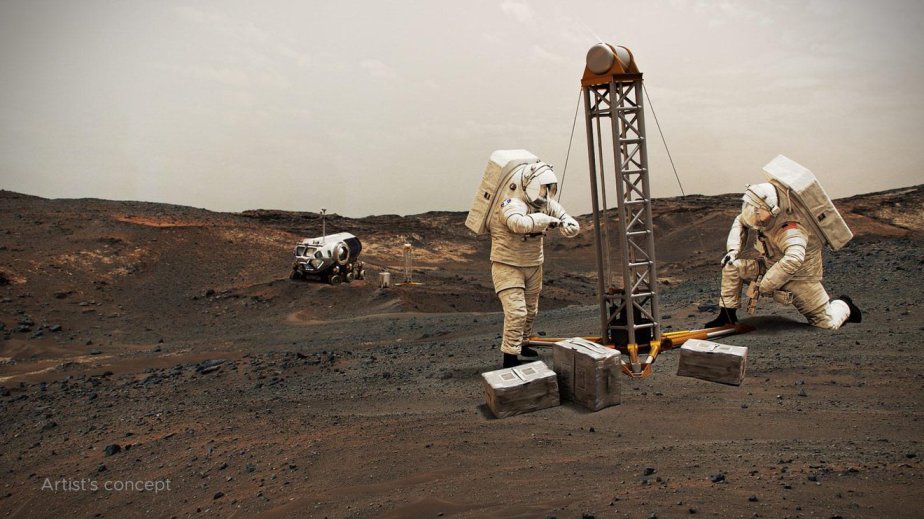
In this artist’s concept, NASA astronauts are drilling into the Martian interior. The agency has created new maps that show where ice is likely to be easily accessible to future astronauts. NASA
“These ice impacts provide a valuable form of ground truth because they show us places where the presence of ground ice is certain,” said Gareth Morgan, co-leader of SWIM at the Planetary Science Institute. “We can then use these locations to test the reliability of our mapping methods.”
In addition to impacts that expose ice, the new map includes HiRISE observations of what it calls “polygonal terrain,” where the seasonal expansion and contraction of subsurface ice causes polygonal cracks in the ground. The sight of these polygons extending around fresh, ice-filled impact craters is another clue that more ice is hidden beneath the surface in these locations.
There are other mysteries that scientists can use this map to study.
“The amount of water ice found at mid-latitude locations on Mars is uneven; some regions seem to have more than others, and no one really knows why,” said Nathaniel Putzig, another SWIM co-leader at the Planetary Science Institute. “The latest SWIM map could lead to new hypotheses about why these changes are happening.” He added that it could also help scientists adjust models of how the ancient Martian climate evolved over time, leaving more ice deposited in some regions and less in others.
SWIM scientists hope the project will serve as the basis for the proposed Mars Ice Mapper mission, an orbiter that would carry a powerful radar specifically designed to search for near-surface ice beyond the level confirmed by HiRISE.
NASA selects commercial service studies to support robotic science on Mars. Nine companies have been selected to conduct preliminary studies of commercial service concepts to support low-cost and more frequent missions to the Red Planet.
NASA has selected nine U.S. companies to conduct a total of 12 concept studies on how commercial services could be used to support science missions to Mars. Each awardee will receive between $200,000 and $300,000 to produce a detailed report on potential services — including payload delivery, communications relay, surface imaging, and payload hosting — that could support future missions to the Red Planet.
The companies were selected from among those that responded to a request for proposals from U.S. industry on January 29, 2024.
NASA’s Mars Exploration Program launched a request for proposals to help create a new paradigm for Mars missions with the potential to advance high-priority science goals. Many of the selected proposals focus on adapting existing projects, currently focused on the Moon and Earth, to Mars applications.
These include “space tugs” to deliver other spacecraft to Mars, spacecraft to carry scientific instruments and cameras, and telecommunications relays. The concepts sought are intended to support a broad strategy of partnership between government, industry and international partners to enable frequent, low-cost missions to Mars over the next 20 years.
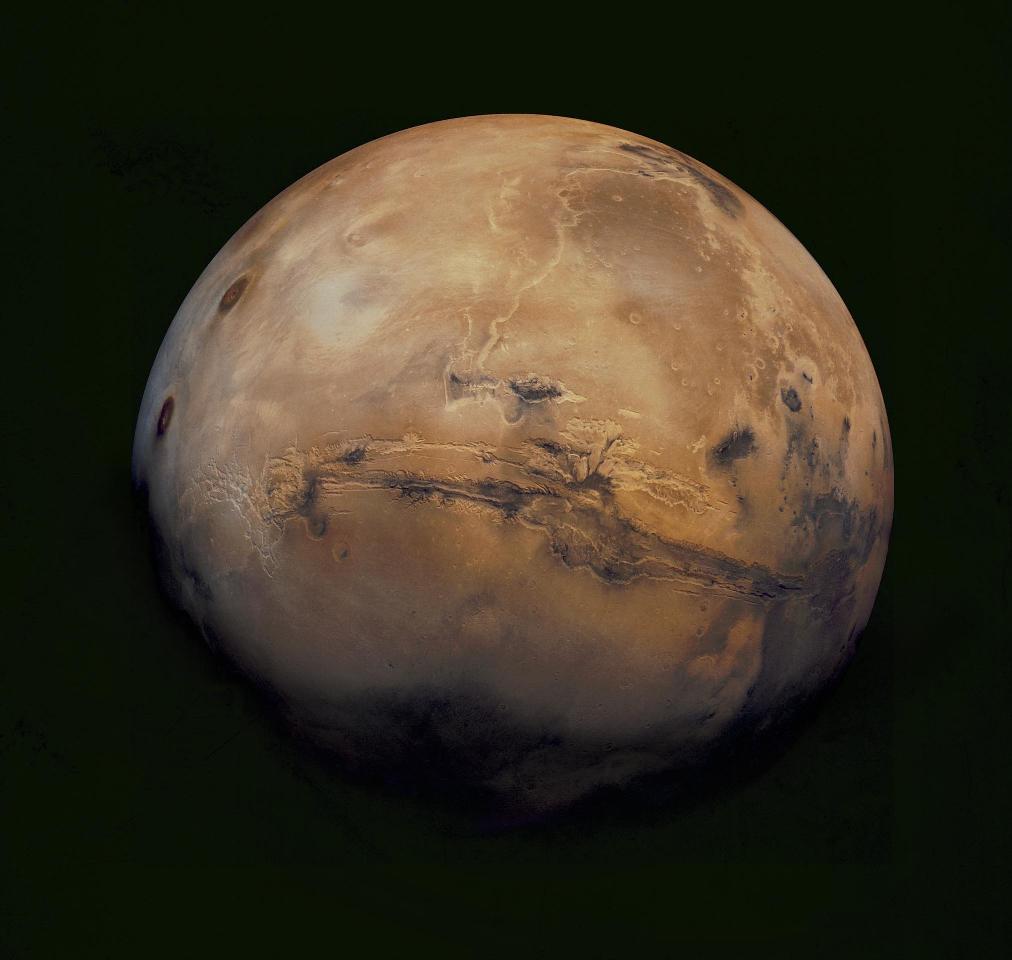
This mosaic is made up of more than 100 images taken by NASA’s Viking 1 orbiter, which orbited Mars from 1976 to 1980. The scar running through the center of the planet is the vast canyon system of Valles Marineris. NASA/USGS
“We are in an exciting new era of space exploration, with rapidly growing commercial interest and opportunity,” said Eric Janson, director of NASA’s Mars Exploration Program. “Now is the time for NASA to begin exploring how public-private partnerships can support science on Mars in the coming decades.”
The selected Mars Exploration Commercial Services studies are divided into categories:
Small cargo delivery and placement services –
Lockheed Martin Corporation, Littleton, Colorado — Lunar Exploration Vehicle Adaptation
Impulse Space, Inc., Redondo Beach, California — Earth Orbital Transfer Vehicle (Space Tug) Adaptation
Firefly Aerospace, Cedar Park, Texas — Lunar Exploration Vehicle Adaptation
Large Payload Delivery and Hosting Services
United Launch Services (ULA), LLC, Centennial, Colorado — Low Earth Orbit Cryogenic Upper Stage Modification
Blue Origin, LLC, Kent, Washington — Spacecraft Adaptation for Low Earth Orbit and Lunar Orbit
Astrobotic Technology, Inc., Pittsburgh — Spacecraft Modification for Lunar Exploration
Mars Surface Imaging Services
Albedo Space Corporation, Broomfield, Colorado — adapting a low-orbit imaging satellite
Redwire Space, Inc., Littleton, Colorado — modifying a low-orbit commercial spacecraft to provide imaging capability
Astrobotic Technology, Inc. — modifying a lunar exploration spacecraft to include an imaging capability
Next Generation Relay Services
Space Exploration Technologies Corporation (SpaceX), Hawthorne, Calif. — adapting Earth-orbiting communications satellites for Mars
Lockheed Martin Corporation — providing communications relay services via a modified Mars orbiter
Blue Origin, LLC — providing communications relay services via a spacecraft adapted for use in Earth and lunar orbits The
12-week study is scheduled to be completed in August, and a summary of the study will be published later this year. The study could potentially lead to future requests for proposals, but is not a commitment by NASA.
NASA is simultaneously soliciting separate industry proposals for its Mars Sample Return campaign, which aims to return samples collected by the Perseverance rover to Earth, where they can be studied using laboratory equipment too large and complex to be carried to Mars. The MSR industry research is entirely separate from the commercial MEP research.
NASA’s Jet Propulsion Laboratory in Southern California manages the Mars Exploration Program on behalf of NASA’s Science Mission Directorate in Washington. The program’s goal is to provide a continuous flow of scientific information and discovery through a carefully selected series of robotic orbiters, landers, and mobile laboratories linked by a broadband Mars-Earth communications network. Science data and related information for all Mars Exploration Program missions are archived in NASA’s Planetary Data System.
The California Institute of Technology in Pasadena, California, manages JPL for NASA.
Pulsed Plasma Rocket (PPR): Secure, Fast Human Flights to Mars. The future of space civilization will depend on the ability to efficiently and quickly move both cargo and people. Due to the extremely long distances involved in space travel, spacecraft must achieve high speeds for reasonable mission transfer times. Thus, a propulsion system that produces high thrust with high specific impulse is essential. However, such technologies are currently lacking.
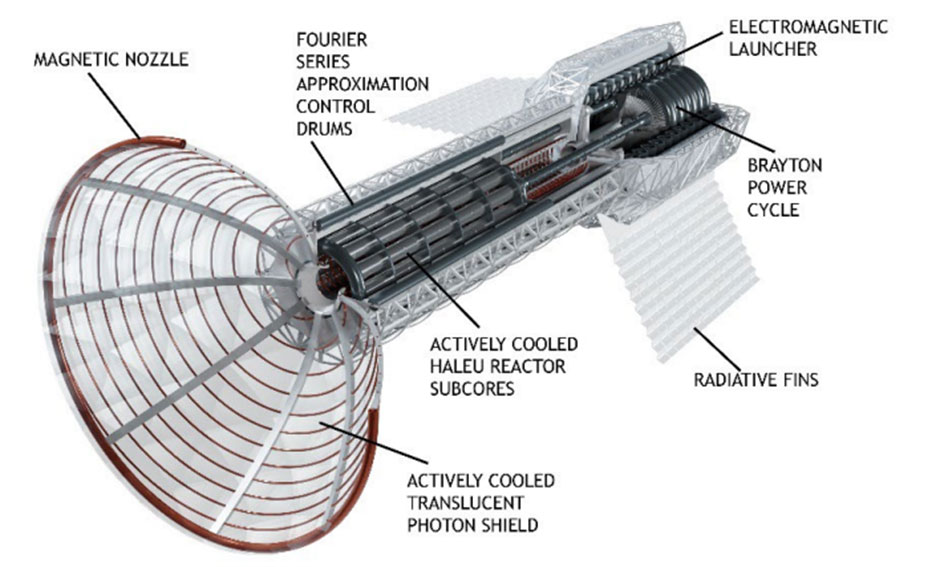
A simplified diagram of a pulsed plasma rocket (PPR) is an artist’s concept illustrating a new approach proposed by the 2024 NIAC Phase II Award winner for possible future missions. Brianna Clements
Howe Industries is currently developing a propulsion system that can generate up to 100,000 N of thrust with a specific impulse (Isp) of 5,000 seconds. The Pulsed Plasma Rocket (PPR) was originally developed based on the pulse fission concept, but is smaller, simpler and more affordable. The exceptional performance of the PPR, combining high Isp and high thrust, has the potential to revolutionize space exploration. The high efficiency of the system allows for manned missions to Mars to be completed in as little as two months. Alternatively, the PPR allows for the transportation of much heavier spacecraft equipped with galactic cosmic ray shielding, thereby reducing crew exposure to negligible levels. The system can also be used for other long-range missions, such as missions to the asteroid belt or even to a location 550 AU away where the Sun’s gravitational lens can be viewed. The PPR opens up a whole new era in space exploration.
The NIAC Phase I study focused on a large, heavily shielded vehicle to transport humans and cargo to Mars to develop a Mars base. Key topics included: evaluation of the system’s neutronic electronics, design of the spacecraft, power system, and required subsystems, analysis of magnetic nozzle capabilities, and determination of PPR trajectories and benefits. Phase II will build on these evaluations and advance the PPR concept.
Meanwhile, the first CHAPEA (Crew Health and Performance Exploration Analog) crew “returned to Earth,” leaving a simulated Mars habitat at the Johnson Space Center in Houston on July 6. The first of three simulated missions, CHAPEA Mission 1, was designed to help scientists, engineers, and mission planners better understand how life on another world might affect human health and performance.
Crew commander Kelly Huston, flight engineer Ross Brockwell, medical officer Nathan Jones and science officer Anca Celariu lived and worked in a 1,700-square-foot, 3D-printed, isolated habitat to support research into human health and performance in preparation for future missions to Mars.
“Congratulations to the CHAPEA 1 team on completing a year in a Mars-like environment,” said NASA Administrator Bill Nelson. “Through the Artemis missions, we will use what we learn on and around the Moon to take the next giant leap: sending the first astronauts to Mars. CHAPEA missions are critical to developing the knowledge and tools needed for humans to live and work on the Red Planet.”
The crew emerged from the habitat and returned to the arms of family and friends after a 378-day simulated mission on the surface of Mars that began June 25, 2023.
This high-fidelity simulation involved the crew performing a variety of mission types, including simulated Mars walks, robotic operations, habitat maintenance, exercise, and crop production. The crew also faced intentional environmental stressors in their habitat, such as resource limitations, isolation, and confinement. Over the next two weeks, the volunteers will perform post-mission data collection activities before returning home.
“We have planned the last 378 days with the many challenges crews could face on Mars in mind, and this crew has dedicated their lives during this time to achieving these unprecedented operational goals,” said CHAPEA Principal Investigator Grace Douglas. “I look forward to diving into the data we have collected, preparing for the CHAPEA 2 mission, and ultimately, a human presence on Mars.”
While NASA works to establish a long-term presence for scientific discovery and exploration on the Moon through the Artemis campaign, analog missions like CHAPEA are providing scientific data to validate systems and develop technology solutions for future missions to Mars.
Two more one-year CHAPEA missions are planned, with the next scheduled to launch in 2025. Subsequent missions will be nearly identical, allowing researchers to collect data from more participants, expand the data set, and gain a broader perspective on the impact of realistic Mars resource constraints, isolation, and confinement on human health and performance.
NASA has several other avenues for collecting isolation research data, including the human research analog, Antarctica and other analogs, and human spaceflight missions to the International Space Station to support key research objectives that will inform future human missions to the Moon and Mars.
The CHAPEA mission simulations are unique in that they test the effects of long-term isolation and confinement with the addition of realistic Mars-like communication delays to Earth (up to 44 minutes round trip) and resource constraints specific to Mars, including the more limited power system that might be supported on the space station and other analogues.




